Why Now Is the Best Time to See the Fall Colors and Elk Rut in This Popular Colorado National Park

Wondering when to hit the trails or snap that perfect photo in Colorado’s famous alpine park, a place where the snowy peaks and mountain lakes will leave you speechless?
I found myself pondering the same question before my 5 month van life adventure brought me to this Colorado natural wonder in late March. Honestly, it was still way too wintery to be able to see the park’s highlights.
Here’s a quick guide to the visitor seasons in this iconic park: (Hint: Don’t come in the middle of winter.)
- Peak Season: June to September
- Shoulder Seasons: May to early June and September to October
- Off-Peak Season: November to April
Next up, I’ll give details into the nitty-gritty of each season, highlighting can’t-miss events and giving you a monthly climate rundown. Whether you’re planning on spending a day or a longer one, conquer Longs Peak or a picnic around Bear Lake, these insights will help you plan the best time to visit Rocky Mountain National Park.
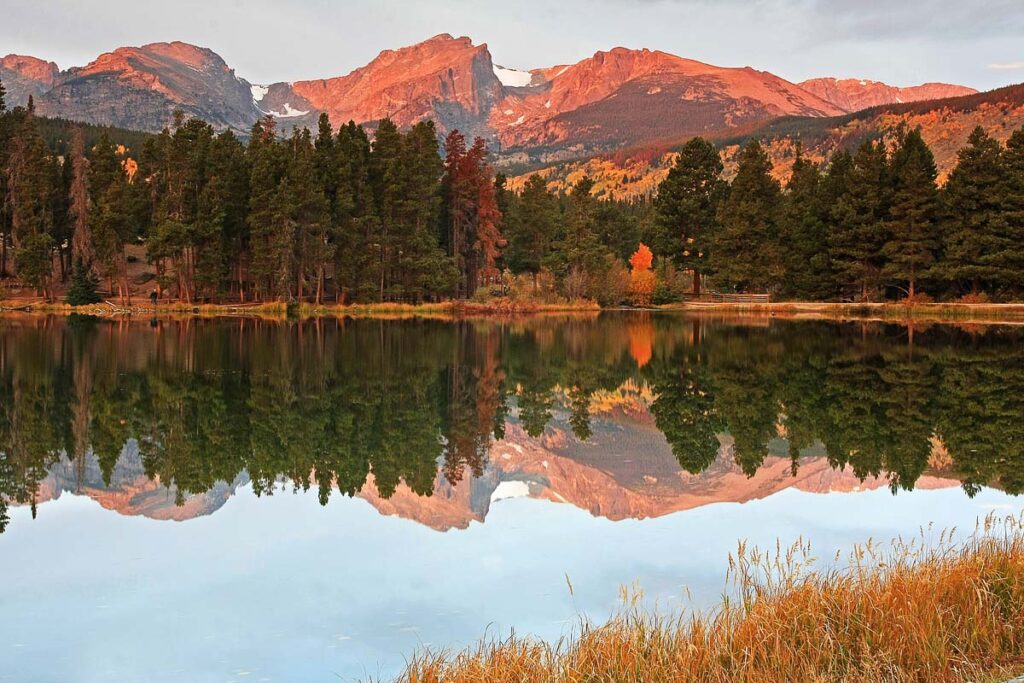
Best Time to Visit Rocky Mountain National Park
Best Time of Year to Visit
The best time to go to Rocky Mountain National Park is undoubtedly during the peak season, from June to September. This period is the only time of the year when it’s warm and sunny with no snow to stop you in your tracks.
You’ll get prime wildlife spotting conditions, with colorful wildflowers and clear alpine lakes. It’s also when the full park is accessible, including the highest elevation trails and scenic drives like Trail Ridge Road.
Best Time for Good Weather
For those in pursuit of the perfect weather, late June through early August will have mild temperatures that range from 60°F to 80°F during the day, though nights can be cooler, perfect for cozy campfires. The sun smiles kindly on the park, keeping the trails dry and the skies clear, ideal for every outdoor activity under the Colorado sun.
Best Time for Smaller Crowds
The best time to avoid the crowds is during its shoulder seasons, May to early June, and again from September to October. These times see fewer visitors due to the cooler weather and transitional nature, with daily visitor numbers dropping significantly from the peak season highs. You’ll have the trails more to yourself, far from the summer crowds.
Cheapest Time to Visit
The cheapest time to visit is during the off-peak season, from November to April. During this window, you’ll find that lodging prices can drop by as much as 30-40% compared to the peak summer months. For instance, I came in March and all the lakes were iced over and the mountains were covered in snow, so you’ll be trading in summer hikes for snowy adventures.
Best Time for Stargazing
Due to the elevation and the temperatures, stargaze in the summer. This national park is part of the International Dark Sky Park, so you’ll always get crisp, clear nights perfect for capturing the galaxy’s wonders without the hindrance of light pollution.
📖 Read Also: 7 US National Parks with Jaw-Dropping Night Skies
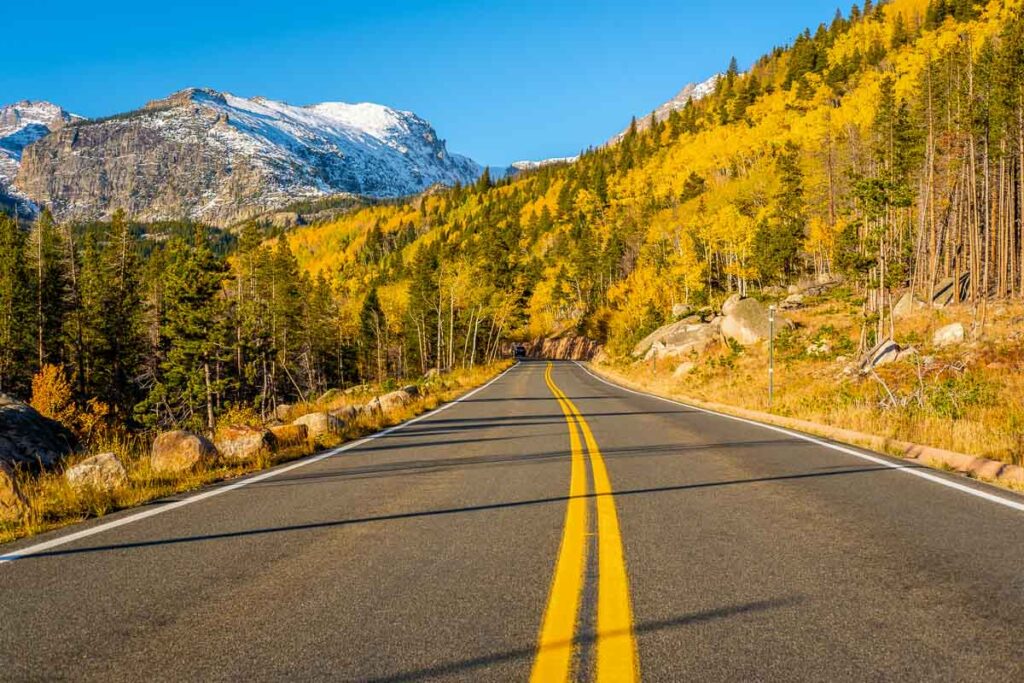
Worst Time to Visit
The worst time to visit Rocky Mountain National Park would arguably be from late November through February. This period brings deep snow, making many trails inaccessible and driving conditions potentially hazardous. Besides, the cold bite of winter reduces the chance of seeing the park’s famous wildlife, as many animals tend to retreat to more sheltered areas.
Park Closures
Rocky Mountain National Park is open 24 hours a day, every day of the year. However, certain roads, like Trail Ridge Road, and facilities may close seasonally due to snow, typically from late October to June. Always check the park’s website or visitor centers for the most up-to-date information on closures and opening times.
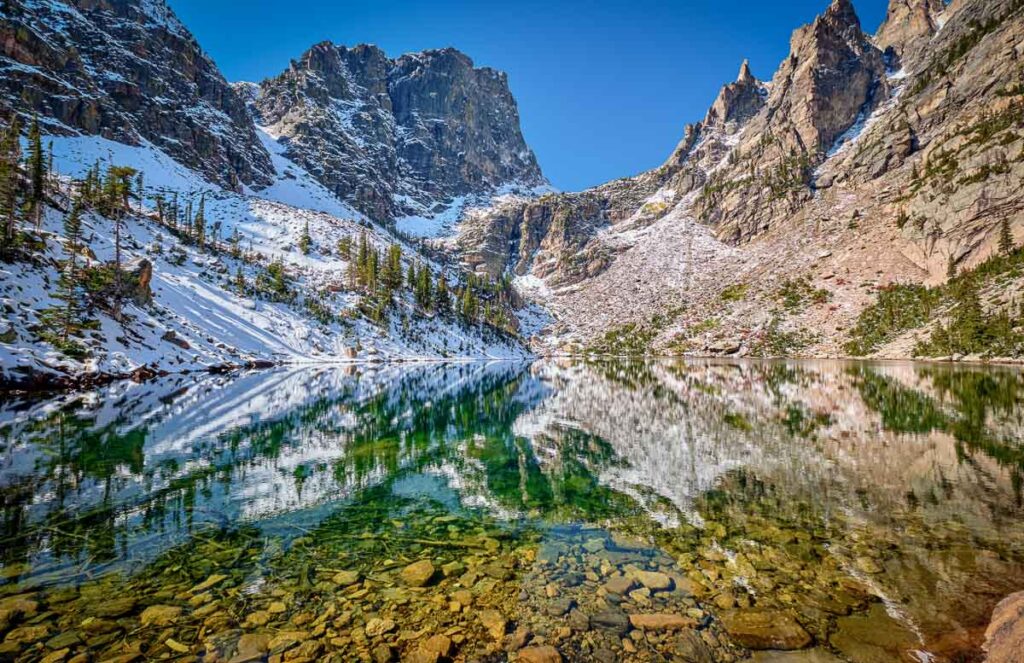
Seasons at Rocky Mountain National Park
Spring (March to May)
Spring in Rocky Mountain areas is when the snow starts to recede, and the meadows slowly turn from white to green.
March and April can still be quite snowy, making for some epic late-season snowshoeing and cross-country skiing. But as May rolls around, the lower elevations begin to clear up, revealing hiking trails that have been asleep under the snow for months.
Wildlife, too, starts becoming more active. Elk and deer move to lower elevations in search of new grasses, making wildlife spotting more accessible. Black bears emerge from hibernation, and birdwatchers can enjoy the return of migratory species.
However, spring weather in the Rockies can be unpredictable: sunny one minute and a snowstorm the next. Just be sure to come prepared with layers and a flexible itinerary. Some higher-elevation roads and trails remain snowbound and closed to summer activities.
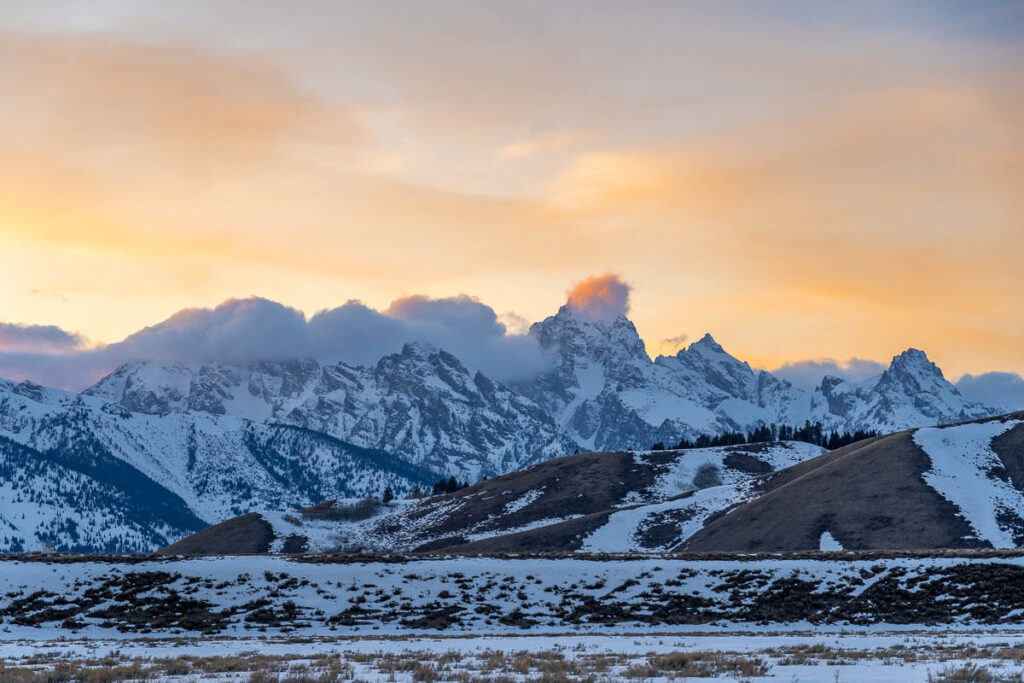
Summer (June to August)
From June through August, the park is buzzing with activities, beautiful landscapes, and wildlife.
It”s the only time of the year the park is fully operating because the weather is just divine. It’s warm enough to swap jackets for t-shirts during the day but still cool enough at night to gather around a campfire. Temperatures hover around the comfortable 60°F to 80°F (15°C to 27°C) range, making it perfect weather for just about anything outdoorsy.
With over 300 miles of trails, ranging from easy, family-friendly walks to challenging, push-your-limits hikes, this is the time when the higher-elevation trails are finally snow-free.
Wildlife viewing in summer is also top-notch. Elk to moose are often spotted grazing in the meadows or ambling through the forests. Meadows explode in a riot of colors, with wildflowers blooming in every hue imaginable.
But being the best season, this means crowds. The park sees a significant influx of visitors, and popular spots can get pretty packed.
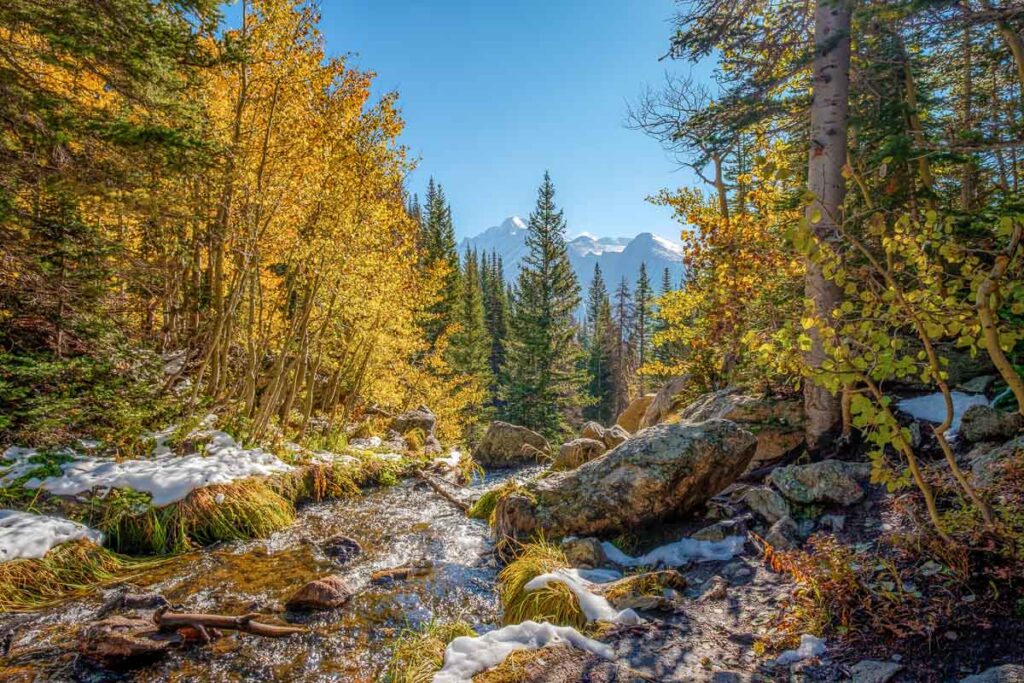
Fall (September to November)
Fall in Rocky Mountain National Park means shades of orange, yellow, and red dotting the landscape. Starting in September, the aspen trees begin turning the mountainsides into glowing seas of gold.
It’s cool, often perfect sweater weather, with daytime temperatures that are just right for hiking without working up too much of a sweat.
Late September or early October is when the fall colors are typically at their peak. Plus, this timing often coincides with the elk rut. The bugling calls of the bull elks echo through the valleys as they vie for the attention of the females.
With the summer rush behind us, the park feels more peaceful. Trails that were packed just a month ago are much quieter now.
While days can be gloriously sunny, nights start to get chilly, and the higher elevations might even see some early snowfall.
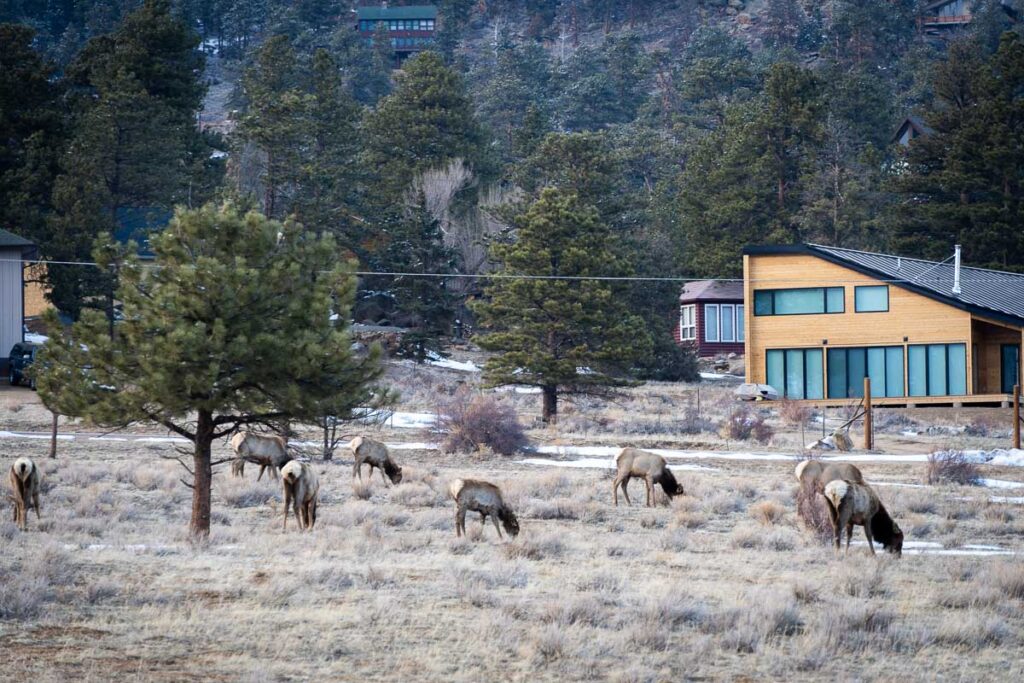
Winter (December to February)
In winter, the park is covered in a thick blanket of snow, with the Rockies standing tall against a backdrop of clear blue skies. Temperatures can plummet below freezing, easily entering the 0°F to 30°F (-17°C to -1°C) range.
Rushing rivers turn into frozen sculptures, and the trees are sparkling with frost. During the season, expect anywhere from 60 to 80 inches (152 to 203 cm).
Snowshoeing and cross-country skiing become the best ways to explore. But if you do come, come prepared. Winter weather in the Rockies can be unpredictable, with sudden snowstorms and whiteouts not uncommon. Layering is key, and so is having the right gear: insulated, waterproof clothing, and perhaps most importantly, snow chains or tires for your vehicle.
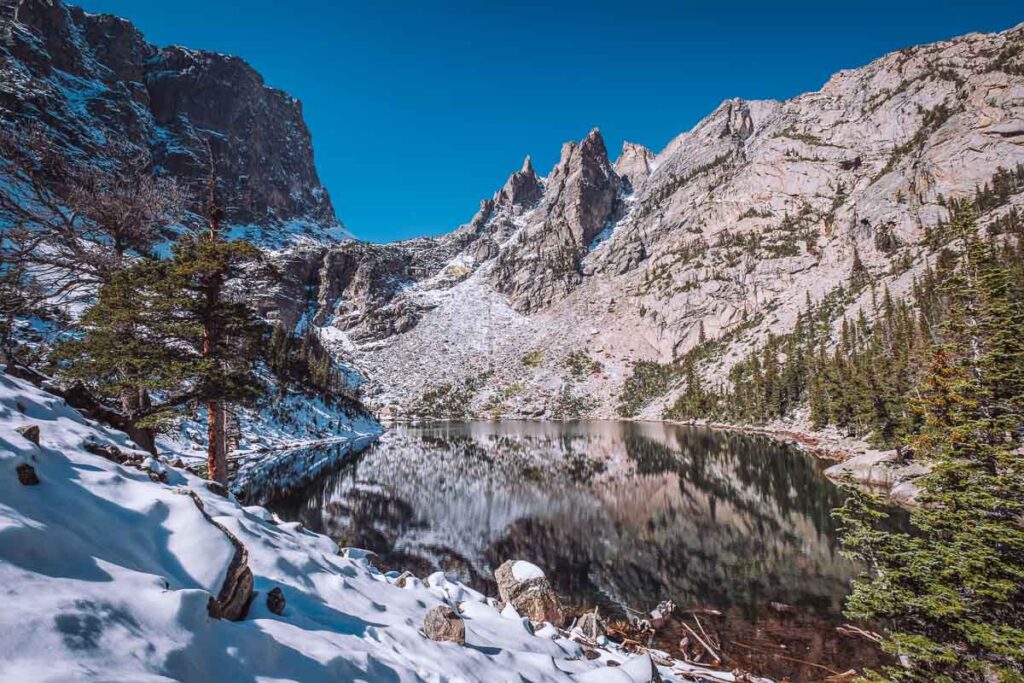
Rocky Mountain Weather By Month
This is a month-by-month overview of the average high and low temperatures, along with precipitation and snowfall statistics for Rocky Mountain National Park:
| Month | Average High | Average Low | Precipitation | Snowfall |
| Jan | 31°F | 13°F | 0.4d | 3.6″ |
| Feb | 34°F | 15°F | 0.7d | 4.1″ |
| Mar | 43°F | 22°F | 1.2d | 6.1″ |
| Apr | 51°F | 28°F | 4.0d | 6.5″ |
| May | 60°F | 36°F | 7.4d | 2.2″ |
| Jun | 71°F | 44°F | 6.5d | 0.0″ |
| Jul | 77°F | 49°F | 7.6d | 0.0″ |
| Aug | 74°F | 47°F | 6.8d | 0.0″ |
| Sep | 67°F | 40°F | 4.8d | 0.6″ |
| Oct | 54°F | 31°F | 3.1d | 2.7″ |
| Nov | 41°F | 21°F | 0.9d | 4.6″ |
| Dec | 32°F | 14°F | 0.3d | 4.1″ |
Best Time of Day to Visit
Even in this summer, it’s still a bit cold in the mornings, so late morning would be the most comfortable time to set out on hikes in the Rockies. That being said, wildlife is the most active in the early mornings, so get a head start if you’d like to catch some herds of elk grazing.
Now, let’s break it down by the time of day:
- Morning (7 am – 11 am): Prime time for wildlife spotting with fewer people around. The light is fantastic for photos, and the temperatures are cooler.
- Midday (11 am – 3 pm): Expect the park to be busier as more visitors arrive. It’s a good time to visit popular spots with the warm sun and go on an alpine lake hike.
- Afternoon/Evening (3 pm – Sunset): As the day cools off, many visitors start to head out. Catch a sunset for the perfect end to your day.
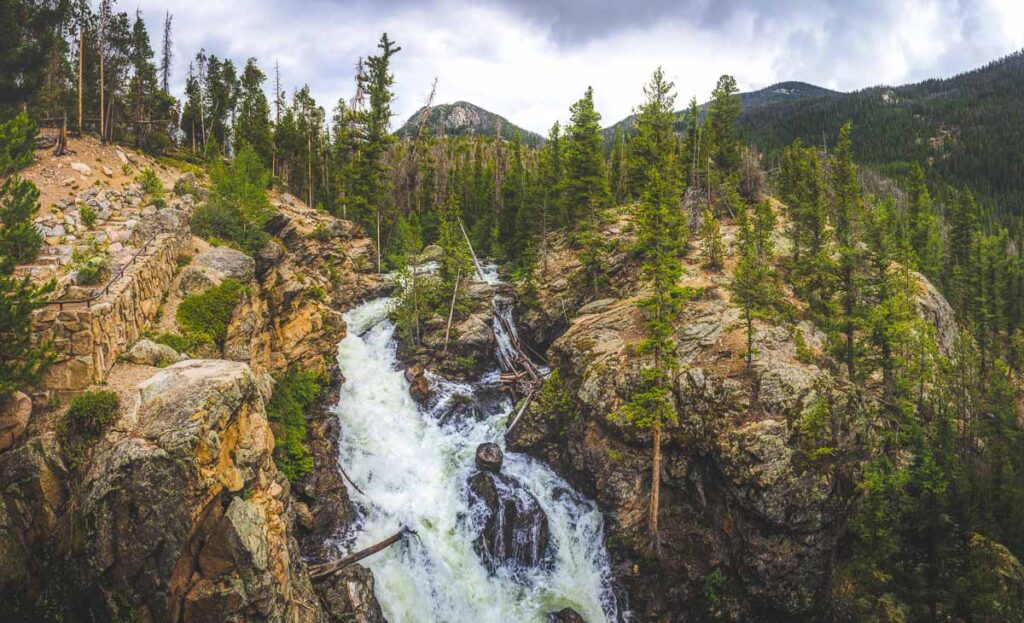
Special Events or Festivals
Here are some special events and festivals taking place in or around Rocky Mountain National Park:
- Winterfest Weekends (February): Celebrate winter with ice sculptures, snowshoeing, sledding, and more at this annual event in Estes Park.
- Wine & Chocolate Festival (February): Indulge in some delicious treats and sample wine from local Colorado wineries at this annual event in Estes Park.
- Duck Race Festival (May): Adopt a rubber duck and watch it race down the river for a chance to win prizes. This quirky, family-friendly event supports local charities.
- Wool Market (June): This event celebrates the art of wool. Expect workshops and demonstrations.
- Estes Park Marathon & Half Marathon (June): Challenge yourself and your heart amidst breathtaking mountain scenery.
- Friends of Folk Festival (June): Tap your feet to the rhythm of folk tunes at this musical gathering.
- Scandinavian Midsummer Festival (June):– Feel like you’ve stepped into another world (or at least another continent) with traditional music, dancing, and food that celebrate Scandinavian culture.
- Rooftop Rodeo (July): Visit Estes Park during this week-long event and experience the thrill of rodeo in the Rockies.
- Bigfoot Days (April): Observe the mystery of Bigfoot with camping, hiking, and a lot of storytelling.
- July 4th Fireworks (July): Mark Independence Day with a stunning fireworks display over Lake Estes.
Before you Close That Tab…Where to Next in Colorado?
I’ve vanlifed south to the north all of Colorado in the dead of winter to early spring. Let me tell you, it was cold, but turn on that buddy heater, and let’s hit the slopes. If you’re looking for more information on Colorado, check out these other destination itineraries.
- Perfect One Day In Mesa Verde National Park Itinerary
- Perfect One Day In Black Canyon Of The Gunnison Itinerary
- Unbeatable One Day In Rocky Mountain National Park Itinerary
- One Day In Boulder Itinerary: What Not To Miss On A Day Trip
- Perfect One Day In Denver Itinerary For First-Timers
- Perfect One Day In Great Sand Dunes National Park Itinerary
Catherine, a seasoned travel writer, has lived in 4 different states and explored 36 states and 28 national parks. After spending two years embracing van life, she's now dedicated to sharing her vast knowledge of day trips across America. Catherine's other works has been referenced in major publications like MSN, Self, and TripSavvy.
| MY FAVORITE TRAVEL RESOURCES |
✈️ Find amazing guided tours and experiences with Viator to maximize your time! 🏘️ Plan ahead and secure your accommodation with Booking.com in advance. 🧾 Rent a car with Discovercars in advance and get the best prices for your day trip adventures. |

